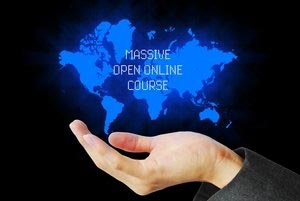E-learning is no longer a new trend. But digital technology currently changes learning at all levels, at a faster rate today than ever before. Traditional educational institutions (universities, schools, seminar providers) struggle to keep up.
Maybe you have asked yourself: How does online learning (or "e-learning") work? And what's so important about it?
Over half of those under the age of 30 have already used e-learning. Many students are considered "digital all-rounders". And millions of learners are enthusiastic participants in MOOCs (=massive open online courses) offered by large global learning platforms. At the same time, however, most universities do not yet have specific MOOC programs.
We are convinced that the digital transformation of learning is already under way and will accelerate further. Much will change in the coming years. Rapid development and continuous innovation, however, can make the range of available online courses quite confusing for you as a user.
Our search portal therefore aims to bring more transparency to the modern online learning markets. Edukatico simply wants to show you the best selection of video-based online courses.
In this article, we want to give you a brief overview of e-learning in general.
E-learning (sometimes written as eLearning) has many names, although an exact definition is controversial. It describes various forms of learning while using digital media.
Mostly for the transmission of the learning content, often also for the communication between the lecturer and the learner. Obviously the Internet plays a central role in this, so that you could also simply call it "learning on the Internet".
But what exactly are the main forms of e-learning?

Strictly speaking, simple texts on websites could also be referred to as "e-learning content". For example the definitions and explanations on Wikipedia.
However, the pure text form is less suited to the demands of users who are looking for a modern learning experience, at least not for learning complex contexts. Wikipedia remains an informative source for definitions and short explanations. But true e-learning can offer more!

These are more advanced than simple texts. Graphics and presentations to "click through", sometimes with audio explanations, have been used for many years. Digital training in companies often includes this.
But today, simple presentations also look more like yesterday´s technology.

These attempt to create a more lively learning experience than just documents with text. When bandwidth was still reduced, this was a good opportunity for knowledge transfer on the Internet. Now it is becoming less important.

With images and sound this can enable quite a lively learning experience. Partly also supplemented by embedded slides, pictures, etc. Often used for online courses in professional career topics.
Also universities have been using video lectures for more than 10 years. MIT´s OpenCourseWare in the U.S. is one prominent example of this.

One of the most innovative forms of digital learning at the moment. With MOOCs (and similar courses), the existing technology is significantly better utilized than with simple learning videos.
Participants´ interactive discussions, digital examinations and tests as well as the possibility of measuring the learning success make MOOCs a great application of learning technology.
Of course some conventional education providers also try to present traditional distance learning as "e-learning". The study letters, which were invented decades ago, are then sent to the students as an electronic pdf document instead of by post.
In our view, however, these providers have not quite understood online learning yet. This form of distance education is therefore expected to lose importance.
What kind of online courses can I find in the Edukatico directory?
At Edukatico you will primarily find:
We want to connect you to the best online education that is possible today!
About 25 years ago, companies started with "Computer Based Training" (often using CD-ROMs). Over recent years, this has continuously been developed into web-based training available online via the Internet.
The almost unlimited possibilities of transmitting information on the Internet is thus systematically used for teaching purposes. And every day new content is added.
Especially for universities digital teaching was an important issue early on.
For universities, teaching (alongside research) is the main task of the entire institution. Many years ago, students began to use digital technologies for their studies. For example, lectures were recorded on video and made available over the Internet.
The accompanying documents for the lecture are often provided on demand via digital learning platforms or Learning Management Systems (LMS). And the digital transformation of the university environment will continue to accelerate in the near future.
With the progressive development of digital technologies, further applications in e-learning were introduced in recent years.
At the beginning, e-learning was mainly understood as a digital version of the knowledge transfer (i.e. simply as a digital form of the paper script or classroom teaching). Meanwhile, however, new forms of digital learning and teaching have arisen. Countless learning apps have been developed and online courses created. Mobile use of these services is also growing rapidly.
And then MOOCs were invented.
The development of MOOCs was one of the most important milestones of the past 10 years. MOOCs use the possibilities of digital interaction for learning purposes, so entirely new learning experiences were created.
Following a short MOOC "hype" a few years ago, the development of modern MOOCs still continues to grow. It remains to be seen whether the rather complicated acronym "MOOC" will be permanently used for these kinds of online courses. But the expressions and terms are really of secondary importance.
And the technological development will not end with MOOCs.
Firstly, more opportunities arise continuously, for example in the field of electronic exams. Around 70% of universities are already active in this regard.
Secondly, the development of Learning Analytics helps in the ongoing improvement of teaching through data-based feedback on students and their learning.
Over the past few years, there have also been many experiments regarding the use of virtual reality - scenarios in a learning environment.
Soon all students will thus have the opportunity to attend lectures under (almost) real-life conditions, while being independent in time and location and with a self-paced learning speed (and the option to rewind difficult sections).
The term "e-learning" looks slightly outdated to some. Nevertheless, digital learning should not be dismissed as a pure buzz word.
With modern e-learning programs, various key changes actually become possible!
"Learning via the Internet" is not just another new tool for learning, like the blackboard, book, or word processing software were in the past.
Modern digital learning brings many fundamental changes to the rules of the game.

The digital distribution of learning content can be done with "zero marginal cost". The content once produced can be transmitted to other learners with virtually no additional cost.
Once created, a MOOC can without any additional effort have large numbers of learners (sometimes hundreds of thousands of participants simultaneously). This in turn has a strong impact on access to education for new learners.
Flexible training when needed, fast learning opportunities around the world in an infinite number of areas and a more cost-effective access for previously disadvantaged groups of learners are thus made possible. Tens of thousands of participants from developing countries in certain MOOCs are just one example.

Distance learning with flexibility in regard to location and time has been around for several decades. Often, however, the rather isolated learning experience as well as the difficulty of the long-term motivation of the participants were criticized.
With the use of digital communication opportunities, interactive communication between students and with the instructor is possible in addition to greater flexibility (with respect to time and place). Discussion forums including a Q&A opportunity for many online courses show how social interaction can be added to e-learning. Thus, for learners, a fully-fledged learning experience becomes possible online.
The next innovation level will be virtual reality applications. To the interactivity, they further add "immersion" (in the 3D learning experience).

Until recently, universities only granted access to their elite knowledge to students who were enrolled there. These students previously had to overcome difficult hurdles and commit to their studies over many years. Other educational institutions with their rich offerings were also strictly bound in place and time.
The digital distribution opportunities now enable society as a whole to easily participate in these high-quality educational teachings. Any state-financed university should be open to the general tax-paying public anyway.
With this democratization of education, knowledge can be shared with society as a whole in a much fairer manner. And the often sought after lifelong learning is thus significantly easier for everyone interested in his or her education.
Actually, there is not even a need for a fundamental discussion about the pros and cons of "e-learning in general", because a stronger digital component of education is – as in other areas of society – unstoppable. It can therefore only be a question of identifying possible opportunities or potential problem areas.
In our view, even the few opportunities mentioned here can have massive positive effects. The better transparency and democratization of education provide better prospects for new groups of learners and for society as a whole.
But are there also disadvantages?
The concerns sometimes voiced do not seem to be fundamental obstacles to a further development of digital learning.
For example, social contacts do not have to be neglected just because someone is completing an online course. And regarding legal issues such as copyrights: Although these would certainly need to be clarified in each individual case, they do not seem to generally prevent online learning. Rather, in our view, practical issues such as a scarcity of resources and budget constraints are the real hurdles which need to be overcome.

The practical applications of e-learning are very diverse. They range from the technical support of classroom teaching (e.g. with digital scripts) to a full video-based online course without any requirement to attend in person.
Examples of a specific use of digital learning:
E-learning is used wherever modern teaching methods are applied to convey educational content flexibly.
"We need to bring learning to people instead of people to learning," was already recognized as a megatrend by the US-learning expert Elliot Masie 15 years ago.

Companies can use digital teaching methods efficiently and economically for the necessary training and education of their employees. In this case, existing online courses from established providers can be used (many of which are also found in the Edukatico directory).
Alternatively, larger companies can order tailor-made e-learning courses from external providers. The content of the learning program can then be designed by the company itself. In large multinationals, dedicated e-learning departments are active in order to retain full control over the entire training process.

Even in schools, digital teaching methods are used increasingly. Here, in addition to the use of various electronic tools, particular attention is paid to the appropriate handling of digital media.
Students therefore learn not only with, but also about the digital offerings. The corresponding media competence is also an increasingly important component of a future-oriented education from the point of view of the curriculum.

Due to the importance of learning and their role as centers of innovation, universities are at the forefront of many e-learning developments. For example, MOOCs were invented at American universities. The most promising developments in the area of virtual reality teaching can also be seen at universities.
The individual faculties of higher education institutions are quite different in this respect: Especially in the field of computer science, innovative e-learning projects are intensively developed and tested.
Interesting from a statistical viewpoint: At the start of the winter and summer semesters of universities, the interest in academic e-learning offers increases rapidly. Digital learning forms can easily serve these peak demands.

Finally, e-learning also plays an increasingly important role in the field of personal education via the Internet. Professional further education is often received through special online courses and private interests can be followed via MOOCs.
For the "lifelong learning" of the population, which is often called for by politicians, almost every day new possibilities are created with modern e-learning services.
The development of e-learning has already led to an unprecedented variety of possibilities.
In coming years, further changes in many areas will be added. An increasing acceptance of digital offers, technical developments and also factors such as improved Internet bandwidth will lead to unimagined opportunities.
The most important trends are:

Of course, these improved educational possibilities do not lead to everyone suddenly getting a university degree. They also have no impact on talent and intelligence. But the learning conditions improve and high quality learning becomes possible for everyone.
Access to education becomes more efficient and equal opportunities improve. It will therefore be a greater responsibility for the individual as to whether he is using his chances and what he ultimately makes of them.
Much will be discussed, new technologies will bring new opportunities, as well as unprecedented applications. And, sometimes, potential challenges for society.
Only one fact remains certain about the future of digital education: Learning will be different.

Edukatico aims to be the best search portal for video-based online courses.
With thousands of online courses covering 22 subjects, our directory gives you a comprehensive and wide selection. You can easily compare and rate online courses.
Many free courses, high-quality content from top universities and the latest MOOCs from international providers will always give you the opportunity to find something suitable.
Are you interested in online courses? Subscribe to our newsletter!
Or browse our directory with thousands of online courses!